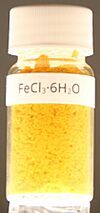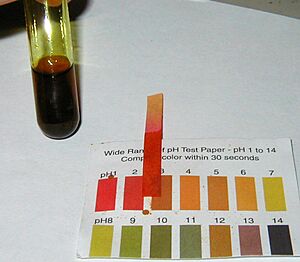Iron(III) chloride facts for kids
Quick facts for kids Iron(III) chloride |
|
|---|---|
| IUPAC name | Iron(III) chloride Iron trichloride |
| Other names |
|
| Properties | |
| Molecular formula | |
| Molar mass | 0 g mol-1 |
| Appearance | Green-black by reflected light; purple-red by transmitted light; yellow solid as hexahydrate; brown as aqueous solution |
| Odor | Slight HCl |
| Density |
|
| Melting point | |
| Boiling point | |
| 912 g/L (anhydrous or hexahydrate, 25 °C) | |
| Hazards | |
| NFPA 704 |
|
| Flash point | Non-flammable |
| Except where noted otherwise, data are given for materials in their standard state (at 25 °C, 100 kPa) | |
Iron(III) chloride, also known as ferric chloride, is a common chemical compound made of iron and chlorine. You can find it in two main forms: one without water (called anhydrous) and one with water (called hydrated). Both forms easily absorb moisture from the air. Iron(III) chloride is very useful. It helps clean water and is used to etch, or carve, designs into metals.
Contents
What it Looks Like
Iron(III) chloride can appear in different colors depending on its form. When it's a solid without water, its crystals look dark green when light reflects off them. But if you hold them up to the light, they can look purple-red. When it's mixed with water, it often forms a yellow or brown solution. These colors come from how light interacts with the iron and chlorine atoms.
Different Forms of Iron(III) Chloride
Iron(III) chloride comes in different forms, depending on whether it has water molecules attached to it.
Anhydrous Form
The anhydrous form means it has no water. It's a solid that looks like dark green crystals. These crystals melt at about 307.6°C. When heated even more, it turns into a gas.
Hydrated Forms
When iron(III) chloride is exposed to water, it forms hydrates. These are compounds that have water molecules as part of their structure. Hydrated forms are deliquescent, which means they absorb moisture from the air and can even turn into a liquid. The most common hydrated form is called the hexahydrate, which has six water molecules.
How it Behaves in Water
When you dissolve iron(III) chloride in water, it creates a brown, acidic solution. This means it has a low pH, like lemon juice. The iron particles in the water can change over time, forming tiny clusters. This special behavior is very important for how it's used to clean water. It can also dissolve in other liquids, like certain types of ethers.
How Iron(III) Chloride is Made
Large amounts of iron(III) chloride are made every year.
Making the Anhydrous Form
One main way to make the anhydrous (water-free) form is by reacting iron metal with chlorine gas at high temperatures. This process is called direct chlorination.
- 2 Fe + 3 Cl
2 → 2 FeCl
3
Making Aqueous Solutions
Solutions of iron(III) chloride in water are also made in factories. This can be done by reacting iron oxide (like rust) with hydrochloric acid.
- Fe
2O
3 + 6 HCl + 9 H
2O → 2 FeCl
3(H
2O)
6
Another way is to react iron metal with hydrochloric acid, and then add chlorine.
- Fe + 2 HCl → FeCl
2 + H
2 - FeCl
2 + 0.5 Cl
2 + 6 H
2O → FeCl
3(H
2O)
6
How Iron(III) Chloride Reacts
Iron(III) chloride is a very reactive chemical. It acts in two main ways: as an acid and as an oxidizing agent.
As an Acid
The anhydrous form of iron(III) chloride is a strong Lewis acid. This means it can accept pairs of electrons from other chemicals. This property makes it useful as a catalyst in many chemical reactions, especially in making organic compounds. For example, it helps in reactions where new bonds are formed in organic chemistry.
As an Oxidizing Agent
Iron(III) chloride is also an oxidizing agent. This means it can take electrons from other substances, causing them to change. For instance, it can turn iron powder into iron(II) chloride.
- 2 FeCl
3 + Fe → 3 FeCl
2
In water, it can oxidize copper(I) chloride to copper(II) chloride.
- FeCl
3 + CuCl → FeCl
2 + CuCl
2
This ability to oxidize is key to its use in etching metals.
What Iron(III) Chloride is Used For
Iron(III) chloride has many important uses in our daily lives and in industry.
Cleaning Water
One of its biggest uses is in water treatment and sewage treatment. It acts as a coagulant and flocculant. This means it helps tiny particles in dirty water clump together into larger "flocs." These larger clumps are easier to remove, making the water clean and clear. It also helps remove phosphate from wastewater.
Etching and Metal Cleaning
Iron(III) chloride is used to etch, or carve, designs into metals like copper. This is very important for making printed circuit boards (PCBs) that are found in almost all electronic devices. The iron(III) chloride reacts with the copper, dissolving away parts of it to create the desired pattern.
Iron(III) chloride aggressively attacks aluminum and dissolves it by breaking down its protective oxide layer and driving a powerful redox reaction.
It's also used in many hobbies involving metal.
Making Other Chemicals
In industry, iron(III) chloride is used as a catalyst to make 1,2-dichloroethane from ethylene and chlorine. This chemical is then used to produce PVC, a common plastic.
It also helps in other chemical reactions, like adding chlorine to aromatic compounds.
In Biology and Medicine
Iron(III) chloride is a part of special stains used in histology. Histology is the study of tissues under a microscope. These stains help scientists see different parts of cells and tissues more clearly. For example, it's used in Verhoeff's stain.
Where it is Found in Nature
Iron(III) chloride can be found naturally, though it's rare. The mineral called molysite is a natural form of FeCl
3. It is usually found near volcanoes and fumaroles (vents that release gases).
Scientists also believe that tiny particles of FeCl
3 are formed in the air when iron-rich dust reacts with hydrochloric acid from sea salt. These particles might play a role in breaking down methane in the atmosphere. There's even a theory that the clouds of Venus contain about 1% FeCl
3 dissolved in sulfuric acid.
Safety Information
Iron(III) chloride is used to treat drinking water, so it's generally safe in very low concentrations. However, the anhydrous form and concentrated solutions are highly corrosive. This means they can cause burns and damage if they touch your skin or eyes. Always handle iron(III) chloride with proper safety gear, like gloves and eye protection.
Related pages
See also
 In Spanish: Cloruro de hierro(III) para niños
In Spanish: Cloruro de hierro(III) para niños







